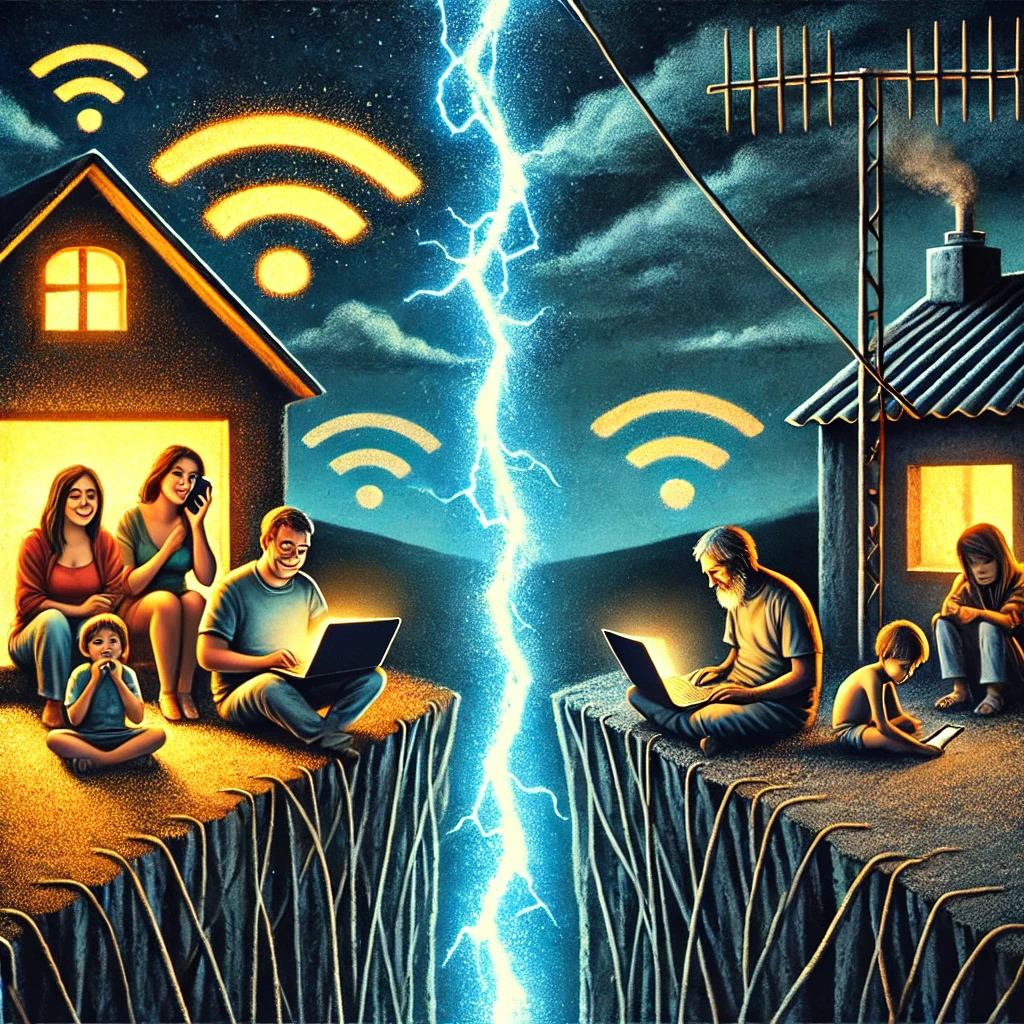Let’s take a moment to think about something many of us don’t even question: technology. Right now, you’re reading this on a device—maybe your laptop, phone, or tablet. You’re connected, and it feels like second nature. But here’s the harsh truth: millions of people around the world aren’t. And it’s not because they’re not interested or prefer a simpler life. It’s because they simply can’t access it.
This gap between those who have access to technology and those who don’t is known as the digital divide, and it’s a bigger issue than many of us realize.
What Is the Digital Divide?
Imagine being a student trying to finish an assignment, but there’s no Wi-Fi at home. Your only option is to find a library—if there’s one open nearby—or try to get it done on your phone, all while worrying about your limited data plan running out. Frustrating, right? Now imagine this isn’t just an occasional hassle but a daily reality.
That’s what the digital divide looks like. It’s more than just not having internet; it’s also about not having the right devices, a reliable connection, or even the knowledge of how to use them effectively.
On one side, we have those with fast Wi-Fi, the latest gadgets, and the skills to navigate the digital world with ease. On the other side are those who are left out—whether because of affordability issues, lack of infrastructure, or insufficient digital literacy.
Why Does the Digital Divide Exist?
The digital divide is not just about money, although that’s a big factor. It’s also about geography and whether your community has been prioritized for technological development.
- Cost: High-speed internet and the latest devices are expensive. For some families, paying for technology means sacrificing essentials like food. And in that scenario, food will always come first.
- Infrastructure: In rural areas, reliable broadband might as well be a fairy tale. Companies don’t want to invest in infrastructure where profits are low, leaving entire communities disconnected.
- Education and Skills: Technology is only useful if you know how to use it. Many people, especially older generations, aren’t familiar with how to operate these devices. Even younger people who are glued to social media might not have the skills for applying to jobs online or learning to code.
Who Feels It the Most?
The digital divide affects everyone, but it’s especially hard on certain groups:
- Low-Income Families: They may have to share one device among multiple family members or rely on public spaces like libraries to access the internet.
- Rural Communities: Limited or nonexistent broadband means even simple online tasks become a struggle.
- Older Adults: Many seniors face challenges learning new technologies or can’t afford them on a fixed income.
- Developing Nations: Countries with inadequate infrastructure fall further behind, making the digital divide a global issue.
The Ripple Effects
You might think, “Okay, so some people don’t have internet—how bad can it be?” But it’s not just about missing out on Netflix. The digital divide has real, far-reaching consequences.
- Education Gaps: During the pandemic, millions of students couldn’t join online classes because they lacked internet access. Imagine trying to keep up in school when you’re miles behind your classmates from the start.
- Job Opportunities: Today, many job applications and training programs are online. If you can’t access them, you’re locked out of opportunities or forced to stay in low-paying jobs.
- Healthcare Disparities: Telemedicine has become more popular, but without internet access, virtual doctor appointments are impossible, leaving many without essential healthcare.
- Social Isolation: Technology connects us to friends, family, and the world. Without it, people can feel isolated and left behind.
Bridging the Gap
The good news? The digital divide isn’t insurmountable. It just requires a mix of effort, creativity, and—let’s be honest—funding.
- Government Initiatives: Programs like the FCC’s Affordable Connectivity Program in the U.S. help make internet access affordable for low-income families. Similar initiatives exist worldwide.
- Public-Private Partnerships: Tech giants like Google and Facebook have invested in expanding internet access to underserved areas, and more companies should follow suit.
- Community Efforts: Schools, libraries, and community centers can offer free Wi-Fi and loan devices to those who need them. These services are often lifelines for people looking to connect.
- Digital Education: Teaching digital skills is just as crucial as providing devices. Workshops and online courses can help people feel confident using technology.
How You Can Help
If you’re fortunate enough to be on the connected side of the divide, there are ways to help bridge the gap:
- Donate Old Devices: Many organizations refurbish used devices and give them to people who need them.
- Volunteer: Teach digital skills at your local library or community center.
- Advocate: Support policies and initiatives that bring broadband access to underserved communities.
- Be Supportive: If someone in your life struggles with technology, be patient and lend a hand. Remember, not everyone grew up with this.
Final Thoughts
The digital divide isn’t just about technology—it’s about people. It affects education, job opportunities, healthcare, and our ability to connect with one another. Closing this gap won’t happen overnight, but every small effort counts.
So, next time you’re scrolling through social media or streaming your favorite show, take a moment to appreciate the privilege of being connected. And then think about what you can do to help someone else gain that same access.





